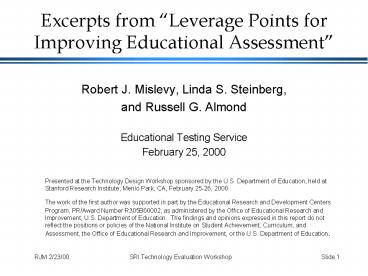Excerpts from Leverage Points for Improving Educational Assessment - PowerPoint PPT Presentation
1 / 9
Title:
Excerpts from Leverage Points for Improving Educational Assessment
Description:
The work of the first author was supported in part by the ... g., in DISC, fill in faux insurance form summarizing conclusions; referral form for dentist. ... – PowerPoint PPT presentation
Number of Views:36
Avg rating:3.0/5.0
Title: Excerpts from Leverage Points for Improving Educational Assessment
1
Excerpts from Leverage Points for Improving
Educational Assessment
- Robert J. Mislevy, Linda S. Steinberg,
- and Russell G. Almond
- Educational Testing Service
- February 25, 2000
- Presented at the Technology Design Workshop
sponsored by the U.S. Department of Education,
held at Stanford Research Institute, Menlo Park,
CA, February 25-26, 2000. - The work of the first author was supported in
part by the Educational Research and Development
Centers Program, PR/Award Number R305B60002, as
administered by the Office of Educational
Research and Improvement, U.S. Department of
Education. The findings and opinions expressed
in this report do not reflect the positions or
policies of the National Institute on Student
Achievement, Curriculum, and Assessment, the
Office of Educational Research and Improvement,
or the U.S. Department of Education.
2
Evidence-centered assessment design
- What complex of knowledge, skills, or other
attributes should be assessed, presumably because
they are tied to explicit or implicit objectives
of instruction or are otherwise valued by
society? - What behaviors or performances should reveal
those constructs? - What tasks or situations should elicit those
behaviors? - (Messick, 1992)
3
Leverage Points for Cog Psych
- The character and substance of the student model.
4
Example a GRE Verbal Reasoning
- The student model is just the IRT ability
parameter ??? - the tendency to make correct responses in the
mix of items presented in a GRE-V.
?
5
Example b HYDRIVE
- Student-model variables in HYDRIVE
- A Bayes net fragment.
6
Leverage Points for Cog Psych
- The character and substance of the student model.
- What we can observe to give us evidence,
e.g., steps, rationales, representations
The work product
7
Leverage Points for Cog Psych
- The character and substance of the student model.
- What we can observe to give us evidence,
- and how to recognize and summarize its key
features.
e.g., use of weak/strong procedures, efficacy of
representations
8
Leverage Points for Cog Psych
- The character and substance of the student model.
- What we can observe to give us evidence,
- and how to recognize and summarize its key
features. - Modeling which aspects of performance depend on
which aspects of knowledge, in what ways.
e.g., space-splitting in Hydrive has conjunction
relationship with domain, strategic, procedural
knowledge prerequisites
9
Leverage Points for Cog Psych
- The character and substance of the student model.
- What we can observe to give us evidence,
- and how to recognize and summarize its key
features. - Modeling how which aspects of performance depend
on which aspects of knowledge , in what ways. - Effective ways to elicit the kinds of behavior we
need to see.
e.g., in DISC, fill in faux insurance form
summarizing conclusions referral form for
dentist.































